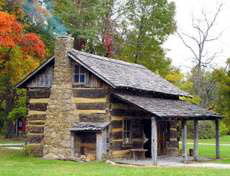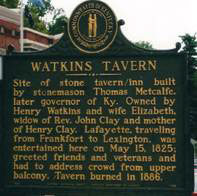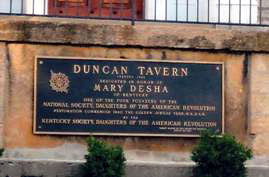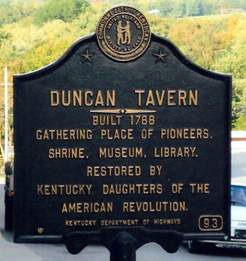Chapter
10
Hazards Ahead
It
was certainly not easy going in the beginning, though.
These elegant homes didn’t dot the landscape until after the first
settlers had wrestled with the trials and difficulties of living in a very unsettled part
of the country. As Theodore Roosevelt
wrote in 1889, “The settlement of Kentucky was
a much more adventurous and hazardous proceeding than had been the case with any previous
westward extension of population from the old colonies; because Kentucky, instead of
abutting on already settled districts, was an island in the wilderness, separated by two
hundred miles of unpeopled and almost impassable forest.” (Ref.867) Just the journey
from Virginia was fraught with danger, there wasn’t much waiting for them when they
arrived.
Most new ‘Kentuckians’ started out with a log cabin as their first form of
shelter. “Since there were no sawmills or stone cutters
in the vicinity, the main source of building material came from the local forests and was
assembled with the use of the broad ax and strong arms.
The builders dug a square trench two feet deep with dimensions as large as
desired. The logs were fastened together with
wooden pegs; round logs were halved together at corners and woofed [crossed
or enter-twined]
with logs or with bark and thatch on poles. This
made for a good shelter, especially when the cracks were ‘chinched’ with
clay.”
(Ref.
960) This was sometimes the only home for many years to
come. (The
word “chinching” was actually a nautical term. It
referred to the process of pressing oakum into a seam
as a temporary measure until the seam could be properly caulked.)
We know from a letter, written in 1812, to James Ware III in Virginia, his brother Thompson, grandson of
James Ware I, was “still very slow lived in his old cabin” at the time. Even though Thompson eventually built a beautiful
home, he was among those early settlers who started from scratch. (Ref.740)
Daily living required tireless work from everyone. One
of the tasks of the young women at that time was “picking geese; a chore commonly
done three or four times a year. A stocking
was placed over the head of
the goose to keep it from biting. The picker
had to wear something old and tie a cover over their hair to keep the ‘down’ out
of it.” (Ref.
960) Not
only were the feathers of the geese used for pillows and comforters, but the main shaft of
the feather became a quill for writing. Everything
served a purpose. This, along with candle making, cooking, mending, weaving, washing, and
taking care of as many as 12 children sometimes, made a very busy and exhausting life for
these early Ware women. placed over the head of
the goose to keep it from biting. The picker
had to wear something old and tie a cover over their hair to keep the ‘down’ out
of it.” (Ref.
960) Not
only were the feathers of the geese used for pillows and comforters, but the main shaft of
the feather became a quill for writing. Everything
served a purpose. This, along with candle making, cooking, mending, weaving, washing, and
taking care of as many as 12 children sometimes, made a very busy and exhausting life for
these early Ware women.
Hazards abounded everywhere. If there
wasn’t the constant concern over Indian raids, the threats of yellow fever, cholera,
snake bites, small pox, or even complications from childbirth were enough to strike terror
in the hearts of many. From old family
letters, we know that incidents occurred such as the following:
“Your Uncle Thompson
Ware’s daughter, Sally, has been as ill as ever any person was, to recover. She had a son and in three weeks, was taken ill
with child-bed-fever. When her life was
despaired of by her physician, Dr. Innes, (and every person that beheld her) they sent for
Dr. Scott. They kept him three days there. Your Aunt Webb went from her last week. She was there two weeks and at the time Dr. Scott
was there. She told me she was satisfied that
she (Sally) would not have lived until morning. When
the doctor came, she said it really appeared like raising the dead. Sally was taken with strong convulsion fits in an
hour after he got here – which lasted nearly two days; one after another. But before he came away, she began to mend slowly
and has been mending ever since. She can now
walk about the yard but not entirely come to her reason.” (Ref. 597)
I suppose you heard his
daughter, Polly Allen, died very suddenly. Her
child was about 3 or 4 weeks old. She had been
quite sick for two weeks, but Mary thought had gotten nearly well. Polly got up in the morning, put on her clothes,
walked to the fire, fell sick, was carried to the bed, and died in a few minutes.” (Ref. 597)
“Charles William I
suppose never will walk a smart child. He was
taken sick and continued so for a year. His
head enlarged (opened) when he was sick at about two years old. He has never walked since; his head very large now. Whether he took too much calomel or what, I
don’t know.” (Ref. 597)
“.
. . [In 1833] Sister Winny’s infant was not two weeks old . . . when news came of the death of her
parents and her brother reached her. She was
kept in so much terror of cholera (because) all the bank officers had died of cholera
– (except Mr. Scott [her husband] and one other), and he [was] called upon to
write wills of persons who had cholera. When
Betsey was told of the death of Papa, Mama, & Isaac, she (without thinking) ran into
Sister Winnie’s room and said, ‘O, Sister, Ma, Pa, & Isaac are dead.’ Sister lost all reason though Dr. Scott went to her
and said, ‘Winnie, you are not sick but frightened.
I assure you, you are not sick’ . . . and when bother was told, he
exclaimed in anguish, he ‘had killed them all.’
Sister Winnie died in a short time after.
Maria took the baby who was William and weaned Lucy who was two years old. The cholera was at its height at that time.” (Ref.
307)
"Dr.
Webb died at my father’s house during the terrible scourge of the cholera. I sat by his bedside and nursed him during his
illness of 8 days and nights – never taking off my clothes as there was so many sick
we could not get help. We had four sick at the
same time. My mother died a few days before
Uncle James.” (Ref.
296)
The mortality rate for women in childbirth and young children was so high that it seemed
that no family escaped the loss of at least one member at a young age.
However, progress did come, and although the risks remained high, Kentucky quickly became
more “civilized.” In 1775, “the total
English population of Kentucky was only a hundred fifty settlers.” (Ref. 901) When the Revolutionary
War ended, American settlements grew rapidly. In
the 1790’s, when the Wares moved to Kentucky, the population skyrocketed and
“according to the census of 1800, the population of Kentucky was around
220,955.” (Ref 901) It would seem that the rather prolific Wares
helped contribute mighty to that number.
 Taverns were built to
welcome newcomers to the region and offer a place to stay.
Mr. & Mrs. Watkins (Henry Watkins and the widowed Mrs. John Clay) kept
the first tavern that was established in Versailles; quite a celebrated hostelry at the
time and “the rendezvous for great lawyers,
pedagogues, and statesmen of the day. Around
the crackling logs in the great fireplace in its spacious hallway such men as John
Crittenden (the father of John J. Crittenden who would later correspond with Josiah Ware)
gathered in the candlelight to discuss the news of the nation, when news traveled only by
horse or stagecoach.” (Ref. 1024)
Taverns were built to
welcome newcomers to the region and offer a place to stay.
Mr. & Mrs. Watkins (Henry Watkins and the widowed Mrs. John Clay) kept
the first tavern that was established in Versailles; quite a celebrated hostelry at the
time and “the rendezvous for great lawyers,
pedagogues, and statesmen of the day. Around
the crackling logs in the great fireplace in its spacious hallway such men as John
Crittenden (the father of John J. Crittenden who would later correspond with Josiah Ware)
gathered in the candlelight to discuss the news of the nation, when news traveled only by
horse or stagecoach.” (Ref. 1024)
Mrs. Watkins was the mother of Henry Clay and “every summer,
Henry Clay made visits to his mother in Versailles and entered freely into the quiet
social life of the village.” (Ref. 181)

Watkins Tavern
Another famous gathering place for local citizens and early pioneers was Duncan Tavern which was built in 1788 and
located in Paris, Kentucky; eventually the county seat for Bourbon County.

Duncan Tavern
 
It has been beautifully restored and can be visited today.

Duncan Tavern
“By the time Versailles was established, dirt roads were opened from one county seat
to another,” so the Wares reaped the rewards of that luxury at least. (Ref. 960) However, it was not until 1830 that
macadamized roads began to be built. James and
Agnes never lived to see that day, nor did any
of their children. |

